In Death Valley’s ‘Star Wars Canyon,’ fighter jet aficionados have a good feeling
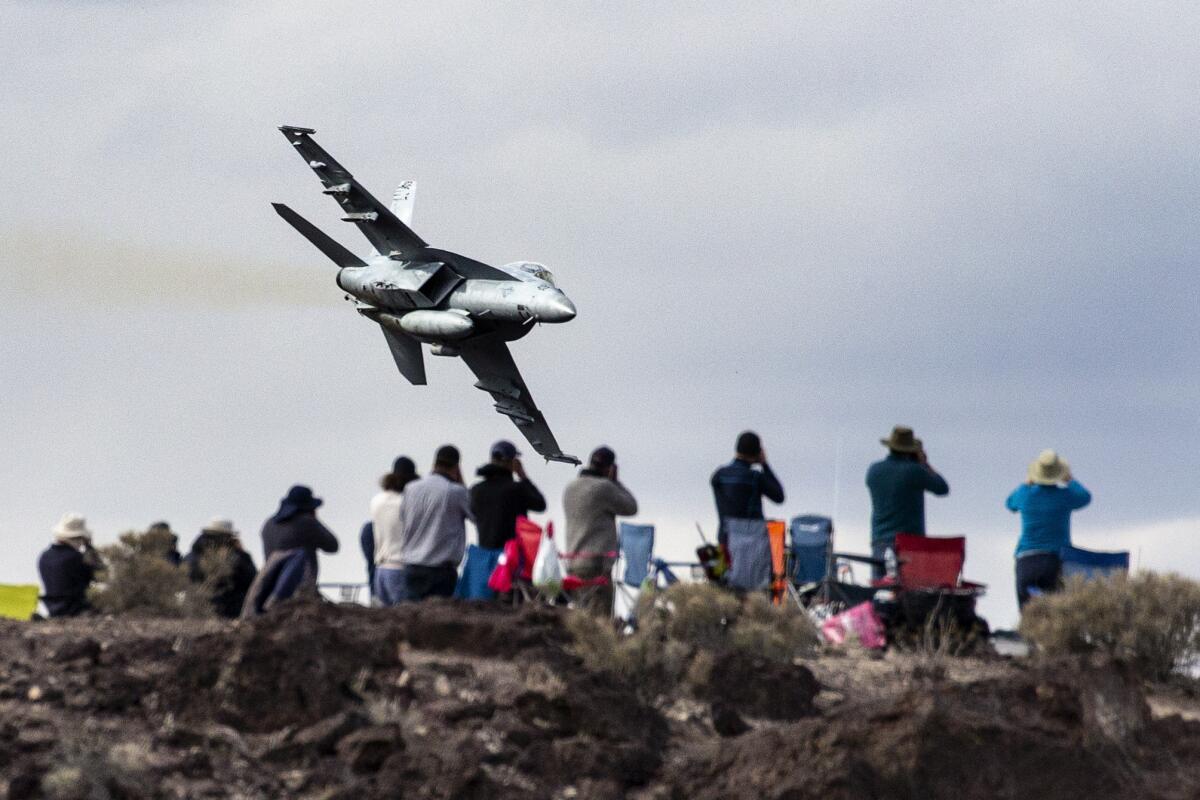
- Share via
The fighter jet was flying low over the desert valley when it banked and dove into a ravine. Between the ancient walls, it rumbled like a giant marble careening around a wooden floor. The noise, a stark contrast with the quietude of the desert, is part of the lure for the military veterans, aviation enthusiasts and photographers who gather at the top of “Star Wars Canyon” on the western edge of Death Valley National Park.
But what they really come for is to catch a glimpse of mechanical birds tearing the sky apart — and the U.S. Air Force and Navy pilots who maneuver them like fictional X-Wing Starfighters.
Hearing the rumble, Evert Van Koningsveld grabbed his camera and rushed over to a railing on the edge of the canyon. He followed the jet with his Canon 80D, snapping 14 photos in as many seconds. He stopped, lowered his camera and watched the jet disappear in a band of clouds stretched out like a string of cotton balls. The sky grumbled.
After the high-speed pass, Koningsveld reviewed each shot with a displeased look on his face.
The photos were vivid and sharp, but none of them had been shot from an angle that emphasized the sleek body of the F/A-18 Super Hornet: its trapezoidal wings, its cockpit, wing strakes or tail. There were no condensation trails on the wingtips or glowing afterburners to convey the maneuverability and power of an aircraft that is capable of traveling faster than the speed of sound.
“That’s aviation photography for you,” he said. “You never know what you’ll get.”
Koningsveld walked back to his car, sat near the edge of the opened trunk and placed his camera next to him. He gazed at the sky and waited, hoping for another chance.
The canyon — more than 5 miles long and up to 5,000 feet wide — is about a three-hour drive northeast of Los Angeles, off State Route 190. On paper, it’s known as Rainbow Canyon because of its gray, orange and red strata. The U.S. Air Force refers to it as the “Jedi Transition,” but almost everyone else refers to it as “Star Wars Canyon.”
For first-timers, it may seem like an odd place to pull over. The desolate landscape offers little beyond the craggy hills, rocks and tufts of brittle flora that look as though a month of rain could never revive them. But the canyon is part of a restricted military airspace called the R-2508 Complex, used for air-combat training, supersonic flight tests and other military operations, and it’s been a magnet for plane spotters for several years.
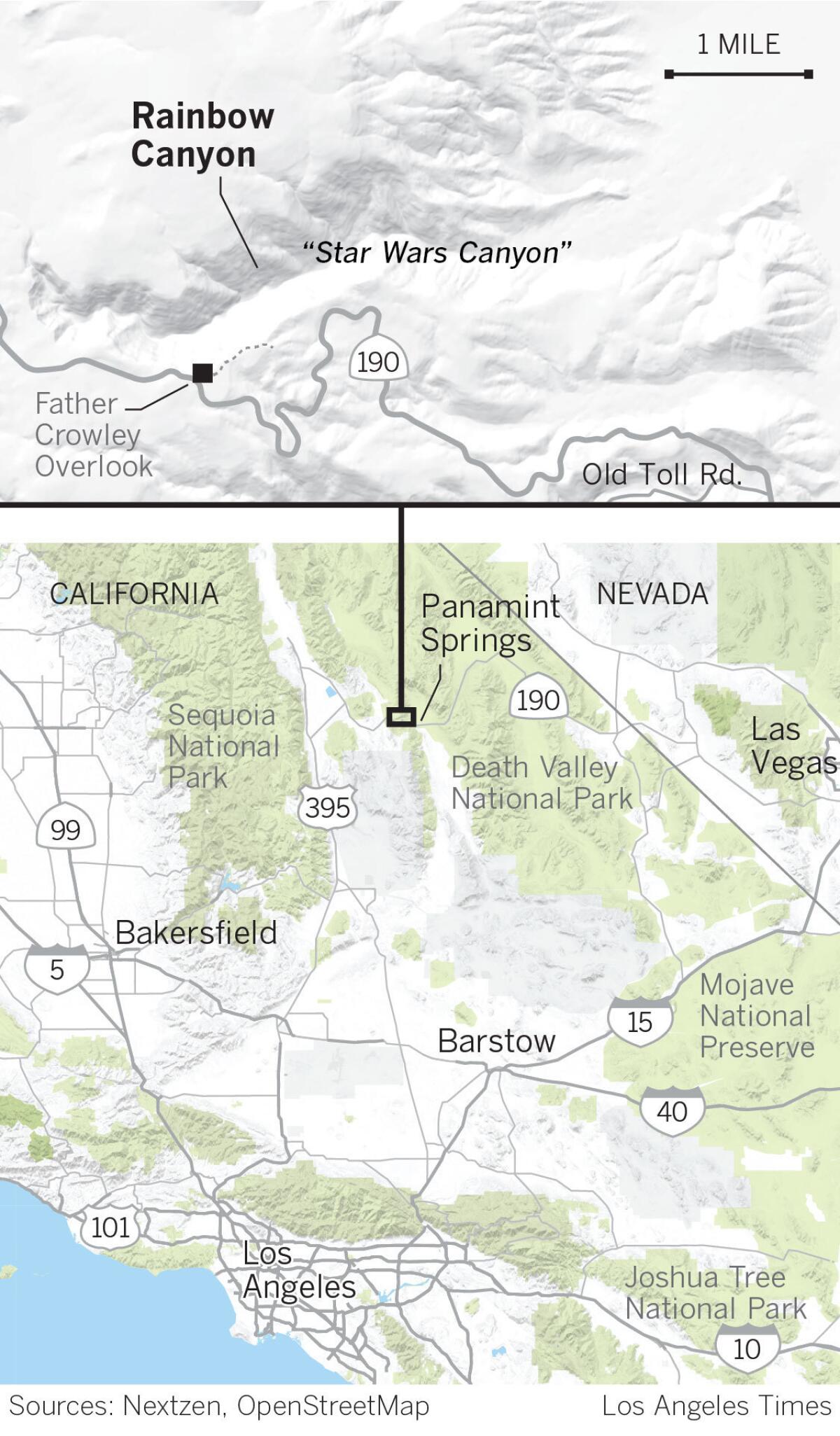
There’s only one requirement for membership in the fellowship: “You have to be bananas for aviation,” says Koningsveld.
Plane spotters who were interviewed over the course of two days in March spoke about the power and the speed of jets that zoom through the area at speeds up to 500 mph. That brief moment in time when feats of engineering obliterate any prior notions about aircraft — and gravity. When a fighter jet transcends its role and becomes a testament to mankind’s technological achievements.
Wearing an orange hat with a back flap, Candace “Candy” Campbell of Pacific Grove, Calif., tried to catch her breath as she explained the thrill she gets from watching.
“It’s pure, raw excitement,” she said. “It’s power. ... those pilots are skilled and they’ve got courage.”
Some of the pilots dive right at the start of the gorge, afterburners blazing. Others change course in the middle of the canyon, flying at eye level with spectators before dropping down. Some pilots fly straight through like a bullet.
“Sometimes they’ll come down and turn so you can see their face and you can take their picture,” said Campbell, 68. “We’ve seen one enter, swing and go right over us.” Some of the images on social media look as though the pilots are truly aware of their audience as they flash a thumbs-up or rock ’n’ roll sign.
Campbell and her husband had set up camp at a vista point called Father Crowley Overlook, named after a Catholic priest (Father John C. Crowley) who served the desert area during the 1920s and ’30s. There are at least two other viewing points nearby, but Crowley is the hot plane spotting spot.
For Campbell, each pass is different from the next. In addition to fighter jets, she’s observed helicopters flying in the same space, and once she watched a C-17, a fat military cargo plane with four engines, drop into the canyon like a Slinky and then — as one spectator described it — “saunter” above the desert floor.
“It just moves side to side so gracefully,” she said. “It’s like ballet. It’s gorgeous.”
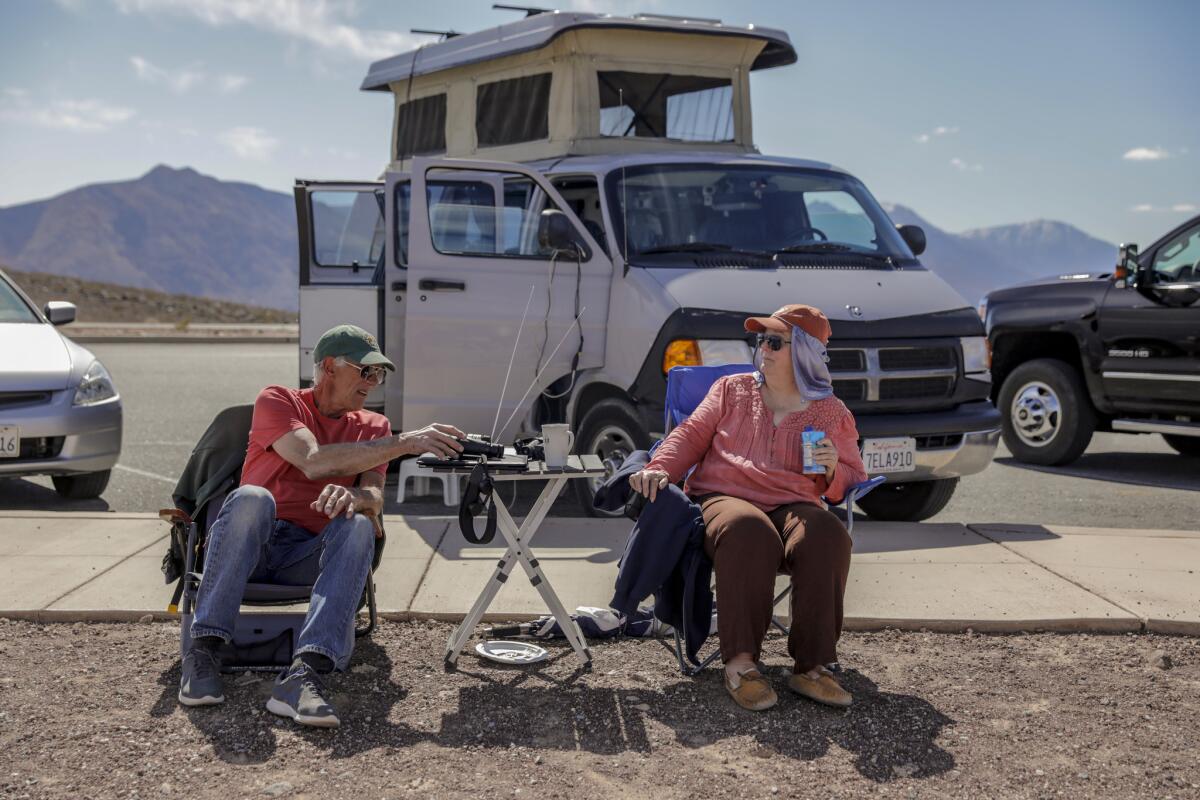
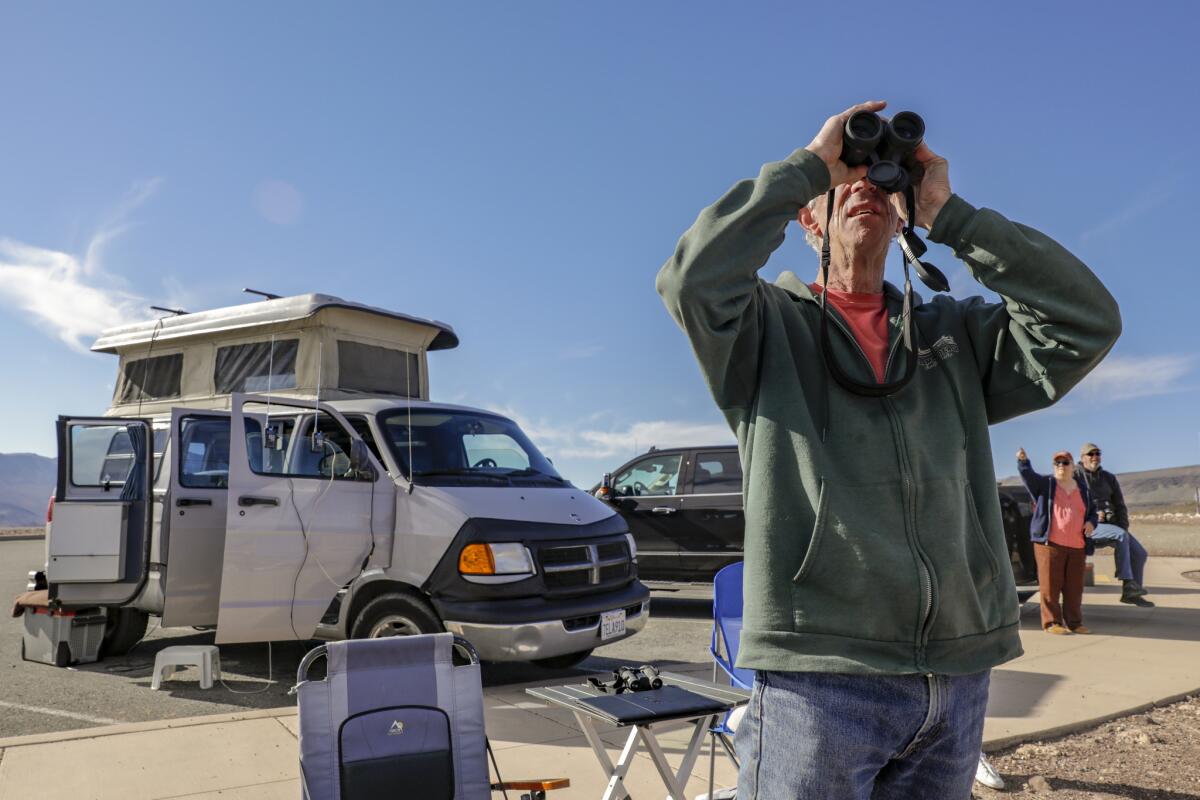
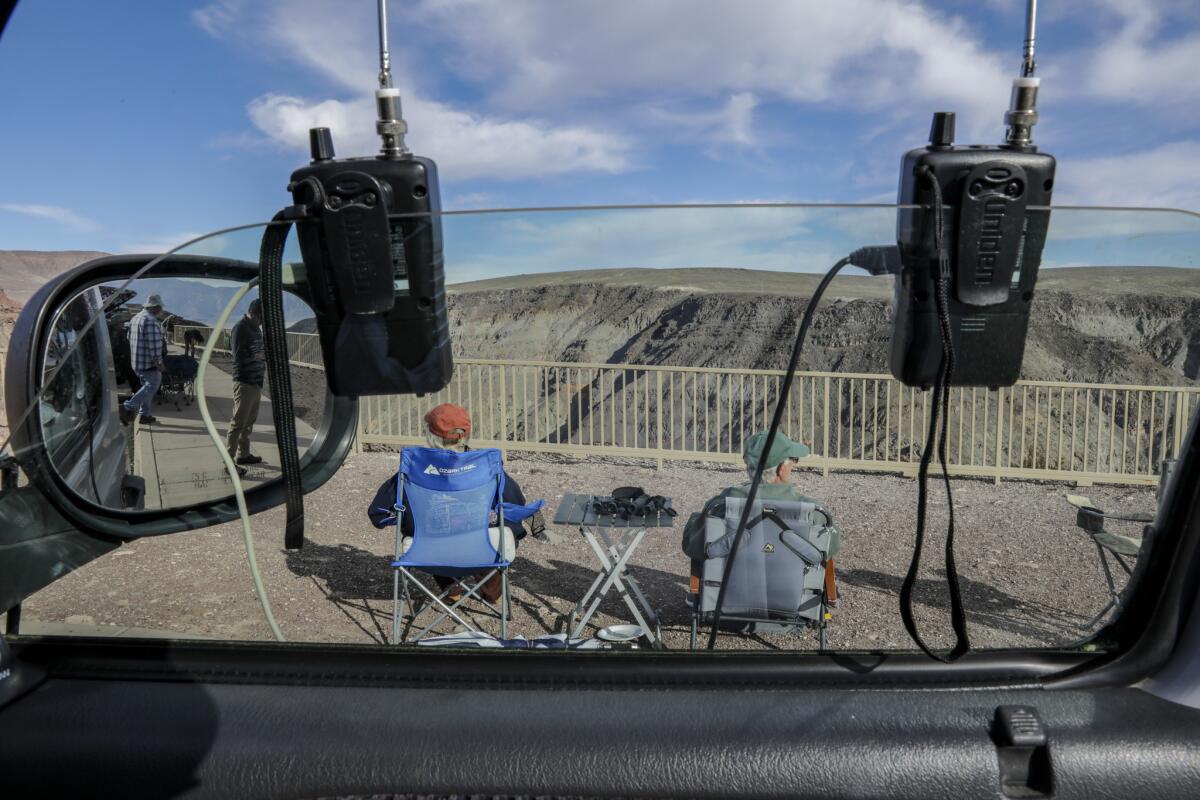
The Air Force and Navy have used “Star Wars Canyon” as a training area since World War II, long before it became part of the national park in 1994, according to Patrick Taylor of the U.S. National Park Service.
Most of the aircraft that pass through come from nearby bases such as Naval Air Weapons Station China Lake, Naval Air Station Lemoore, Edwards Air Force Base, Fresno Air National Guard Base and Nellis Air Force Base in Nevada. Foreign allied forces are also known to make flybys.
Over the years, Taylor said the number of plane spotters has increased, in part because of social media. In 2010, the National Park Service installed a parking lot, a railing along the edge of the canyon and a bathroom at Crowley Overlook to accommodate the growing number of visitors.
Larry Grace, a former Air Force veteran and president of the International Society for Aviation Photography, said the Mach Loop, a high-speed flight training area in the United Kingdom, and “Star Wars Canyon” in Death Valley National Park are two of the most publicized plane spotting areas in the world.
“As pictures got out,” he said, “people asked about where they were taken, and that’s how those areas got popular.”
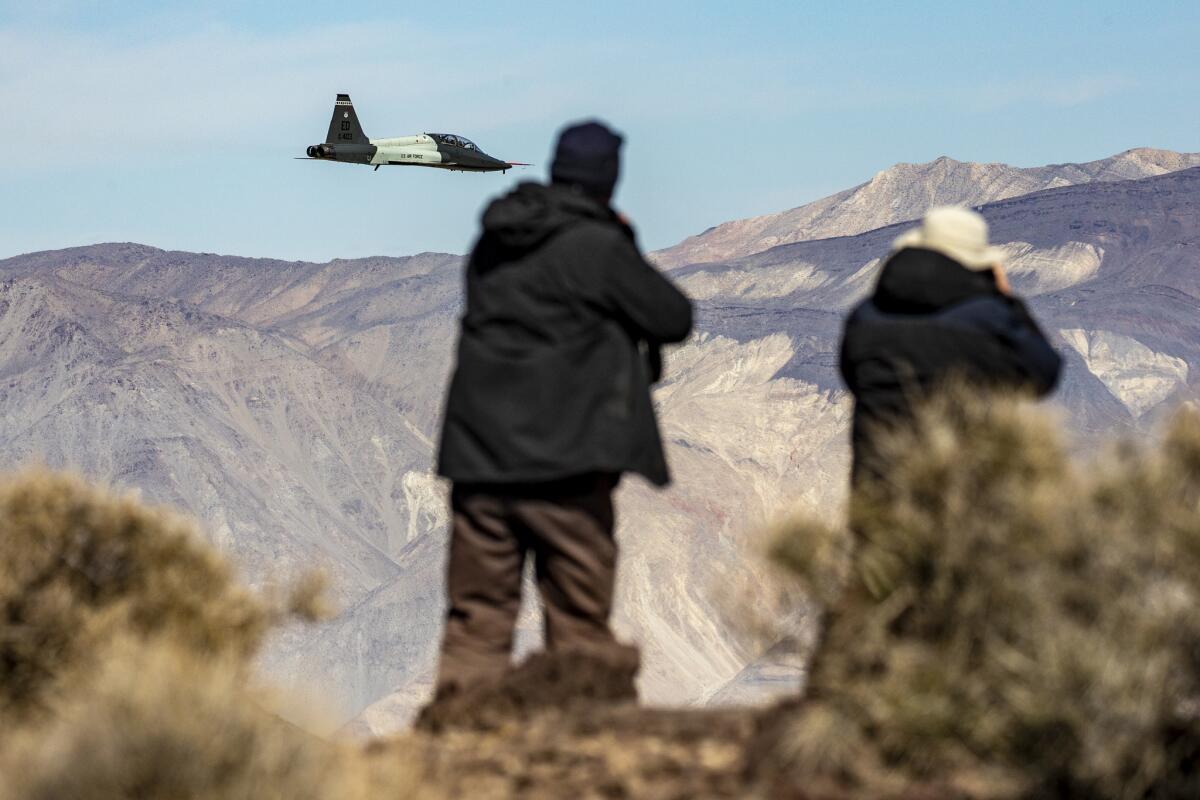
Ten years ago, Koningsveld drove to the canyon and waited for half an hour hoping to see a plane.
The gravelly voiced Dutchman, who became obsessed with aircraft as a child, was not successful in his quest. But he and his wife, Jose (pronounced Josae), were already frequent visitors to the United States, attending annual air shows in Nevada and California, when four years ago, Koningsveld, 61, decided to give “Star Wars Canyon” another try. This time, he spotted a fighter jet, and since then, he and his wife have made annual trips to the desert.
“Now I’m a little more patient. I can stand around all day here, getting old,” he said, chuckling.
Success at “Star Wars Canyon” is frequently about luck. Some days the only things in flight are crows (or as some of the more frequent regulars have come to dub them: “B1-RD.”) And then there are those holy mackerel days when dozens of military aircraft make an appearance.
Experienced plane spotters (many of whom are professional photographers) come prepared. They bring meals. They unload their gear, unfold their chairs, apply sunscreen — and they keep their eyes to the sky.
“If you’re talking to someone or looking somewhere else, you could miss it,” Koningsveld said.
Koningsveld and his family lived in the town of Zeist, not far from a Royal Netherlands Air Force base in the center of the country. He was a toddler when his father took him to his first air show and introduced him to the world of aviation. Eventually, Koningsveld channeled his interest in military aircraft into a freelance photography career. By the early 1990s, he was flying with — and shooting photos for — flight demonstration squadrons such as the United Kingdom’s Royal Air Force Aerobatic Team, known as the Red Arrows, and a Royal Canadian Air Force display flight squadron, called the Snowbirds.
As he waited at the overlook for the next jet to fly through, Koningsveld said he was hoping to spot his favorite plane, an F-15 Strike Eagle — and he did, the following day. “It looks good and it’s enormously powerful,” Koningsveld said.
His wife was sporting a denim shirt with the picture of an F-15, a suggestion, perhaps, of a shared enthusiasm.
“She’s married to me, so it’s by default,” Koningsveld said, laughing. Jose smiled and remained as silent as the desert.
The origins of the canyon’s nickname are up for debate. Some aviation enthusiasts talk about desert scenes in the “Star Wars” movie franchise that were filmed in Death Valley. The exposed rocks on the canyon walls remind them of Tatooine, the home planet of Anakin and Luke Skywalker.
Others suggest that the pilots who fly into the canyon feel as if they’re dropping into the trench of the Empire’s Death Star, avoiding fire from laser canons — just like Luke in “A New Hope.”
But the nickname was not a hot topic among the plane spotters — the European aviation photographers, military brats, veterans and the Campbells — stationed along the canyon rim on a breezy March day. Their focus was elsewhere.
Hours passed. People napped. A woman worked on her tan. Some of the visitors made small talk, stopping mid-sentence whenever they heard the crackling of a radio scanner. A few of them would jump up with their cameras the second they heard a rumble.
Several veterans suggested the experience at “Star Wars Canyon” is analogous to fishing: You wait and you watch and you hope you catch something good.
Some have seen an F-15 Strike Eagle, an A-10 Thunderbolt II (nicknamed the “Warthog”), an F-16 Fighting Falcon — or transport planes like the C-17 or the C-130. Occasionally someone is lucky enough to observe a rare aircraft such as the F-117 Nighthawk, a stealth attack aircraft that was retired in 2008.
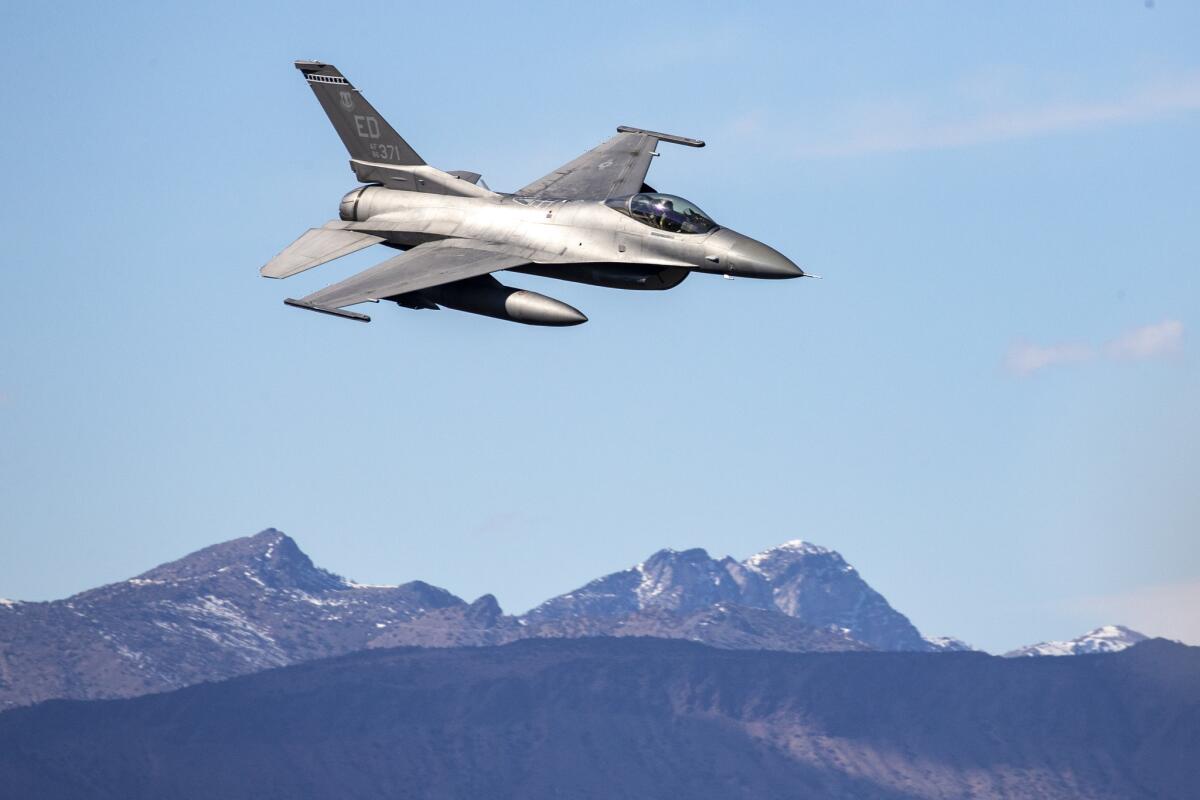
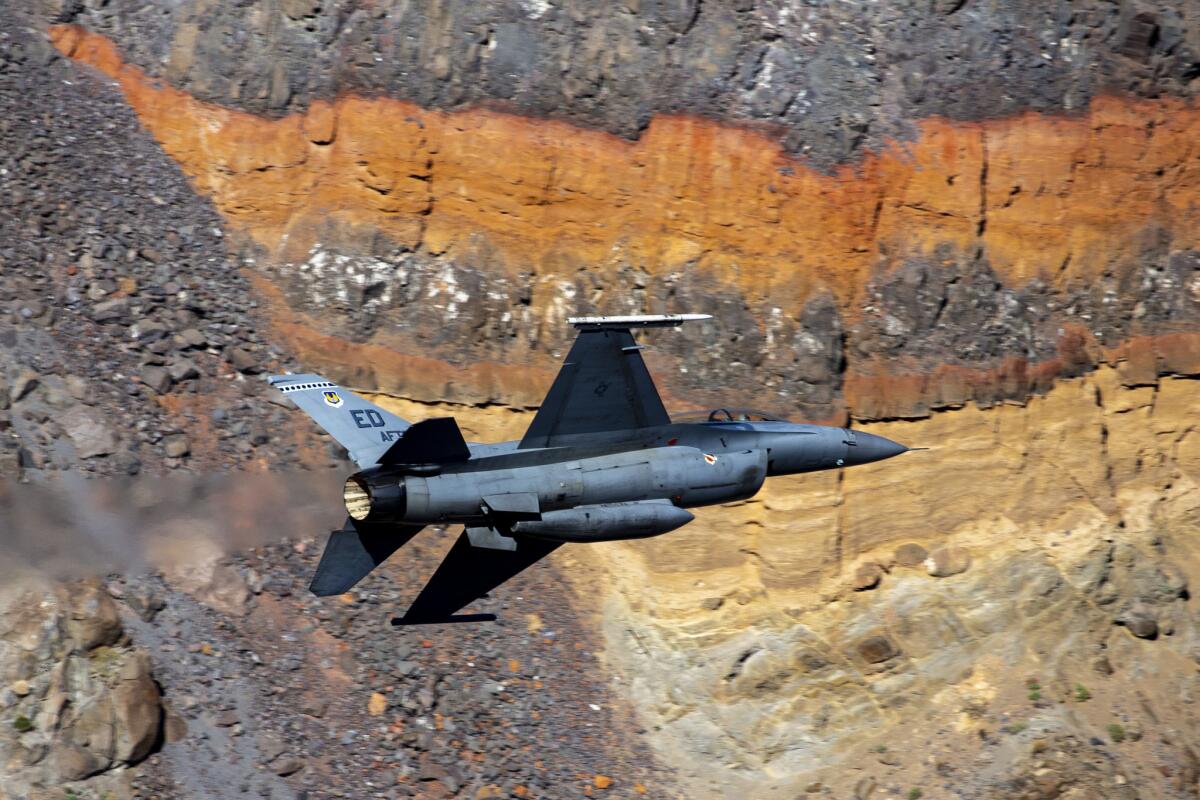
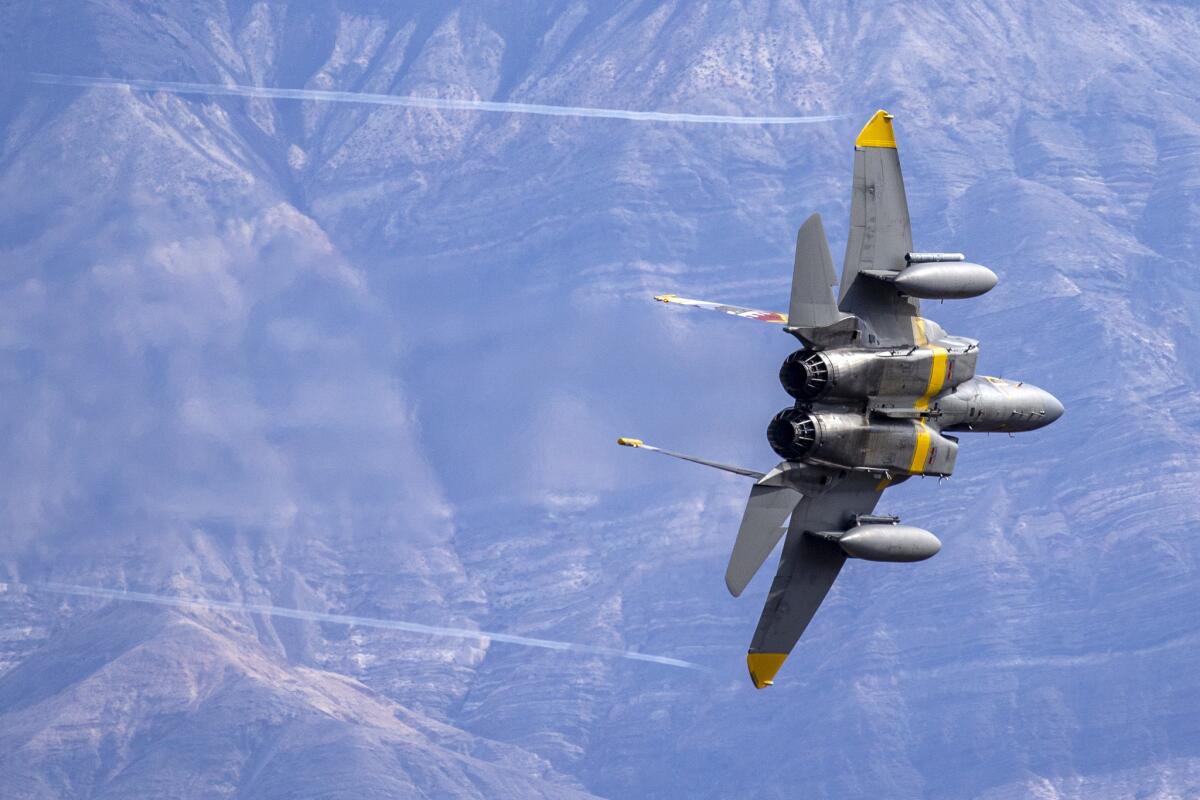

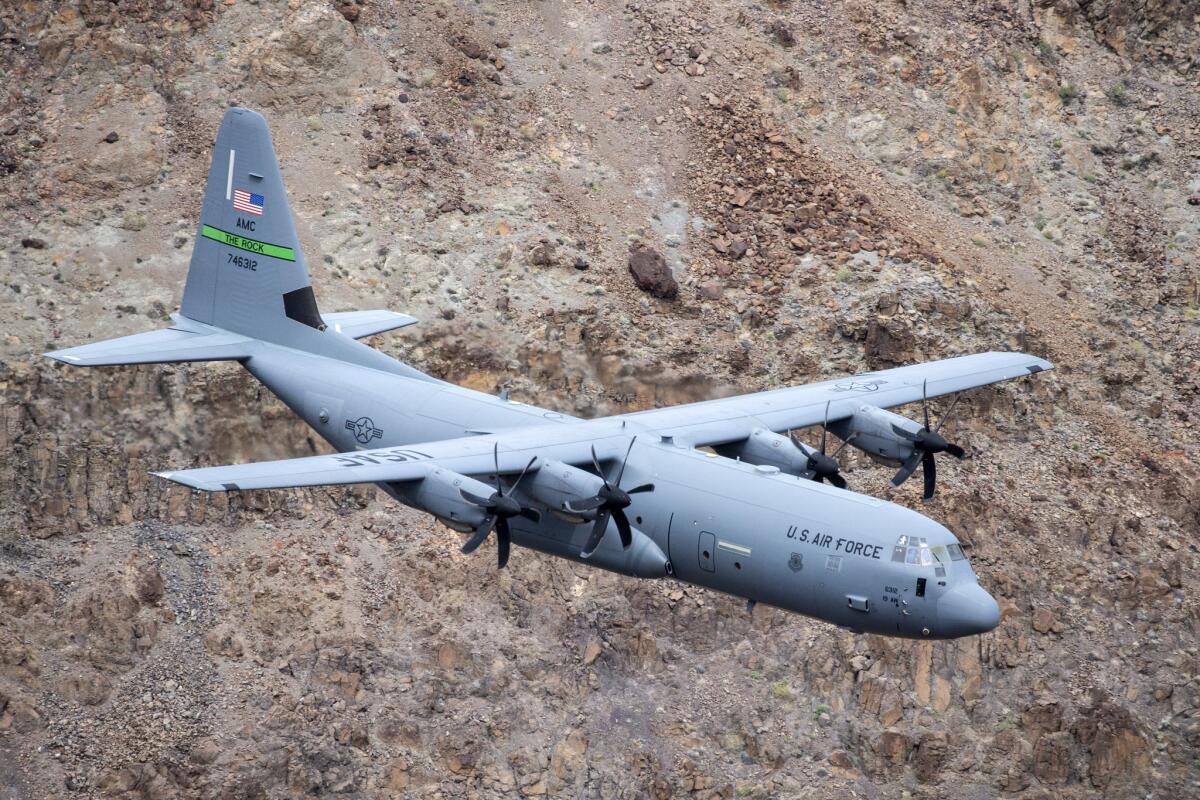
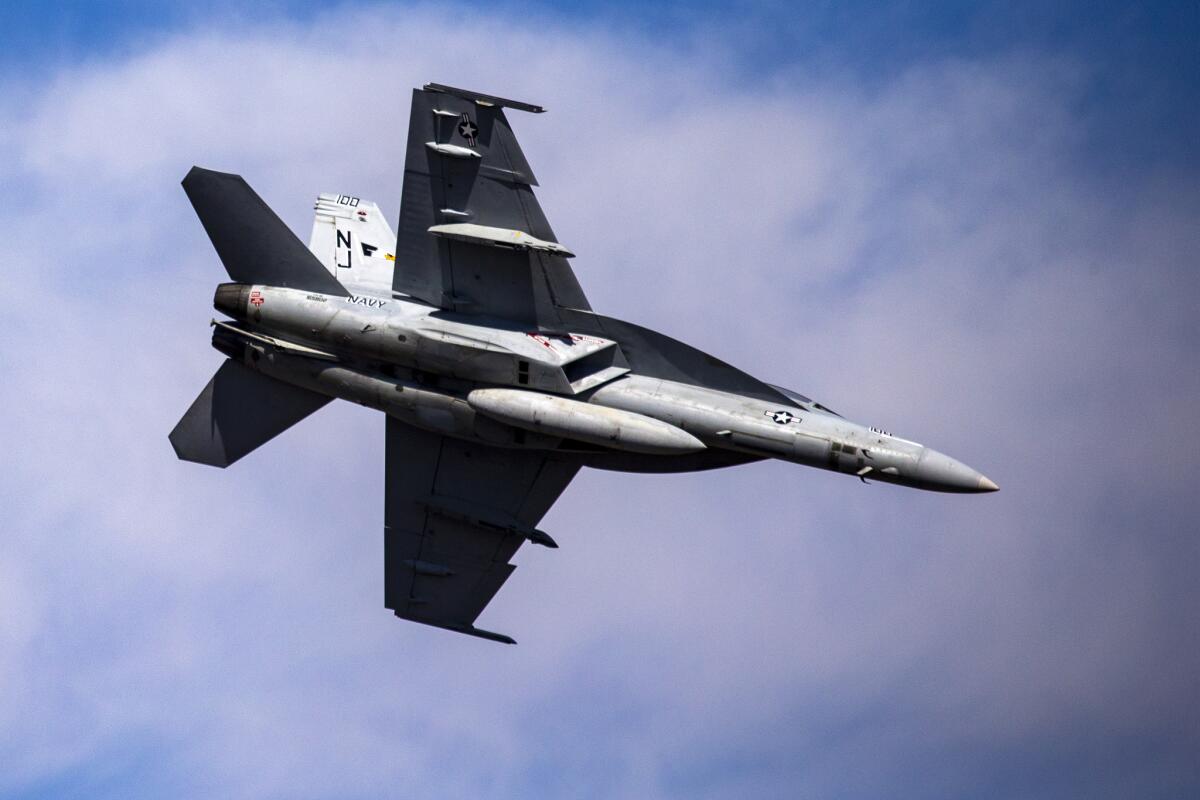
The crowd included a few tourists visiting Death Valley National Park, compelled to pull over at the overlook after spotting the lines of tripods and cameras. What’s everyone waiting for? they asked. Sometimes a fighter jet would appear on the horizon with the answer.
These random encounters can lead to a new hobby, and, in the case of a few, an addiction.
Indeed, that’s how it happened for Campbell, a former landscape photographer, and her 71-year-old husband, Richard.
The couple had long been drawn to Death Valley and the desert landscape. They started to visit the park with their children in the 1970s, but were only vaguely aware that military jets flew in the area. About four years ago, they pulled into the parking lot of Father Crowley Outlook — by chance. The Campbells were sipping tea inside the 2001 Dodge Caravan that they had converted into a camper when they saw a fighter jet burn and turn through the canyon.
Richard and Candy were at eye-level with the pilots — and it was love at first sight.
Now they make the eight-hour trek from California’s Central Coast to the canyon every year, devoting a week to plane spotting. Like the other veterans, they hope they’ll get “buzzed,” a term used to describe what happens when a fighter jet flies low with its afterburners on.
In an email she sent to her children last year, Campbell described such a moment — this one involving an F/A-18 Super Hornet.
“He roars over my head,” she wrote. “And when I say over my head, I am saying he was low … the sky was covered with the jet’s body. [It was] so close it seemed as if I could have stretched up and touched it.”
The Campbells sat on folding chairs at the overlook; a journal they use to log their sightings sat on a small gray table placed between them. Nearby, radio scanners broke the silence, as pilots communicated with their towers. The Campbells were hoping to hear words like “Jedi,” “Sidewinder” and “Charlie” — anything that would give them an advance warning that a jet was requesting permission to fly through the canyon.
Over the years, the regulars have learned to depend on Campbell, who has become something of a human scanner. She seems to spot jets long before anyone else does.
Mike Price, 66, and his wife, Shelley, 61, of Portland, Ore., were visiting Death Valley when they decided to stop at the overlook. It was about 2 p.m. and Campbell alerted everyone to get ready. A jet zoomed by and, all too soon, the moment was over. Price, who couldn’t get a photo because he pressed the wrong button while trying to turn his camera on, voiced a familiar complaint.
“It happened too fast.”
‘Star Wars Canyon’: How I got the story »
Produced by Sean Greene
For more Southern California news, follow @latvives on Twitter.
Sign up for Essential California
The most important California stories and recommendations in your inbox every morning.
You may occasionally receive promotional content from the Los Angeles Times.








